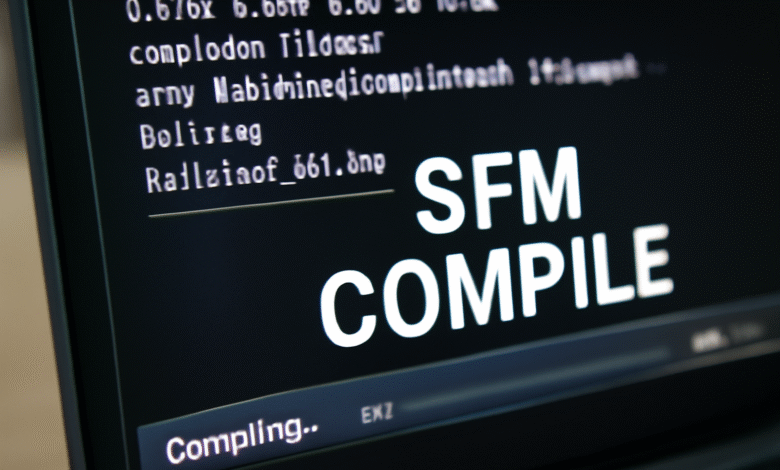SFM Compile: A Complete Guide for Creators and Animators

If you’ve ever played around with Source Filmmaker (SFM), you know how fun it can be to bring your favorite characters and scenes to life. But if you’ve taken the time to craft a cinematic masterpiece, you’ll eventually hit the stage that every animator both loves and dreads—the sfm compile. Compiling is where all your shots, effects, and camera work come together in a polished format. Yet, for many new creators, this step feels confusing, technical, and sometimes frustrating.
In this guide, we’ll break down everything you need to know about sfm compile, from what it really means to how you can optimize the process. Whether you’re a beginner tinkering with your first video or an experienced user trying to speed up workflow, this article will give you the insights you need.
What Does SFM Compile Actually Mean?
When animators talk about sfm compile, they’re referring to the process of turning your SFM project (which is often messy, layered, and raw) into a finished video file. Think of it like baking a cake: your models, lighting, and sound effects are the ingredients, but compiling is the oven that transforms everything into something consumable.
The compile stage involves rendering out frames, applying the correct resolution, encoding the video, and ensuring the timing matches your project setup. For some, this might seem like a simple “click and wait” job, but in reality, the sfm compile process has a lot of small decisions built in. Do you want to prioritize speed or quality? Should you use MP4 or AVI? What about frame rate consistency? Each choice impacts how your final video looks and feels.
The importance of sfm compile also lies in consistency. Without a proper compile, you’ll run into issues like choppy playback, desynced audio, or artifact-heavy visuals. That’s why mastering this process is less about being technical for the sake of it and more about ensuring your creative vision is delivered smoothly to your audience.
Step-by-Step: How to Perform an SFM Compile
So, how do you actually go through with an sfm compile? The steps may vary slightly depending on your project size, but the overall process follows a clear path.
First, you’ll want to check your project timeline inside Source Filmmaker. Make sure all shots are aligned, your cameras are set, and audio tracks are placed correctly. Nothing is worse than spending hours on a compile only to realize a sound effect was muted or a camera cut was misaligned.
Next, navigate to the File > Export > Movie option. This is where the magic begins. You’ll be presented with multiple export settings, such as resolution, frame rate, and output format. For most creators, exporting at 1080p with 30fps is a safe starting point. However, if you’re aiming for cinematic results, bumping it up to 60fps can deliver smoother motion—just be prepared for longer compile times.
Finally, choose the right format. While AVI files are common, they can be enormous. MP4 (H.264) is usually the smarter choice if you plan on uploading to YouTube or sharing on social media. Once you hit export, the compile begins. Depending on the complexity of your project, this might take minutes—or hours. Patience, my friend, is part of the SFM game.
Common Issues During an SFM Compile (And Fixes)
Every creator has experienced it: you wait hours for an sfm compile, only to realize something went wrong. Maybe the audio is off. Maybe the video looks darker than it did in the editor. Or maybe the entire compile crashes halfway through. Don’t panic—these issues are common, and solutions exist.
One of the most frequent problems is audio desync. This usually happens because the audio sample rate or project frame rate doesn’t match your export settings. The fix? Always double-check that your SFM timeline is set to the same frame rate as your export choice. If you’re using external audio files, make sure they’re formatted at 44.1kHz or 48kHz for best results.
Another headache is video artifacts—those weird lines or pixel glitches that pop up in the final compile. Often, this is due to compression settings or GPU rendering hiccups. Switching your export format to an uncompressed AVI and then re-encoding it in a program like HandBrake can clean things up. Yes, it’s an extra step, but the quality payoff is worth it.
Lastly, there’s the dreaded crash mid-compile. If this happens, it usually points to either insufficient system memory or corrupted assets in your project. Try breaking your compile into smaller segments (per scene or per minute) and then stitching them together afterward. Not only does this reduce system strain, but it also gives you checkpoints instead of losing hours of progress at once.
Optimizing Your SFM Compile for Quality and Speed
Let’s face it: nobody enjoys waiting forever for a compile. On the other hand, nobody wants to upload a blurry, low-quality video either. The trick is finding the balance. Luckily, with a few tweaks, you can make the sfm compile process smoother without sacrificing your vision.
Start with your render settings. If your machine is struggling, lower the anti-aliasing setting slightly. You’d be surprised how much faster the compile goes with only a minor drop in quality. For casual projects or test runs, this is a lifesaver.
Another pro tip is to use image sequences instead of direct video export. Instead of compiling straight into an MP4, you can render your project as a series of high-quality PNGs or TGAs. Then, use a video editor like Premiere Pro or DaVinci Resolve to stitch them together. This method not only prevents crashes but also gives you more control over color grading and post-processing.
Finally, don’t overlook the power of hardware upgrades. While SFM is CPU-heavy, having a decent GPU and plenty of RAM significantly reduces compile headaches. If you’re serious about animating regularly, investing in a mid-range graphics card and at least 16GB of RAM will make your compile workflow much more enjoyable.
Why Mastering SFM Compile Matters for Animators
Some beginners treat sfm compile as just a final step they need to get through, but professionals know it’s much more than that. This process is where the technical side of animation meets the creative side. The smoother your compile, the faster you can share your work with the world.
When you understand the ins and outs of compiling, you free up more mental space for creativity. Instead of worrying about crashes or blurry exports, you can focus on storytelling, character movement, and cinematic flair. Your audience might not know the difference between H.264 and AVI, but they’ll absolutely notice if your video stutters or your audio feels out of sync.
In a way, mastering sfm compile is like learning stagecraft in theater. The audience doesn’t see the stagehands, lighting rigs, or sound engineers—but their work is crucial to delivering a professional performance. The better you get at compiling, the more your finished projects will stand out in the crowded world of digital animation.
FAQs About SFM Compile
1. What is the best format to use for an sfm compile?
For most purposes, exporting to MP4 using the H.264 codec is the best choice. It balances quality and file size, making it perfect for platforms like YouTube. If you need raw quality for editing, go with AVI or image sequences.
2. Why does my sfm compile take so long?
Compile time depends on your project complexity and hardware. High-resolution settings, complex lighting, and high anti-aliasing levels all increase render times. Upgrading your CPU, GPU, or RAM can significantly speed things up.
3. How do I fix audio desync during an sfm compile?
Check that your project’s frame rate matches your export settings. Also, make sure your audio files are properly formatted (44.1kHz or 48kHz sample rate). Exporting image sequences and syncing audio in a video editor can also solve the problem.
4. Can I pause or resume an sfm compile?
Unfortunately, SFM doesn’t support pausing a compile mid-process. However, you can export your project in smaller segments (per scene) and render them separately. This creates a “pseudo-resume” workflow that saves time if something crashes.
5. Should I use image sequences instead of direct video in sfm compile?
Yes, many experienced creators prefer image sequences. They’re safer, give you more editing flexibility, and prevent losing progress due to crashes. The only downside is the extra step of stitching them together later in a video editor.




